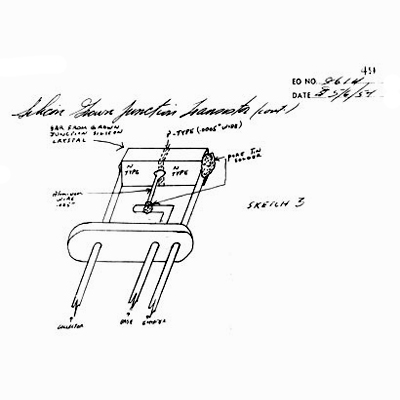博文
半导体里程_博物馆_1954_硅晶体管提供优越的工作特性
||
1954——硅晶体管提供优越的工作特性
Morris Tanenbaum在贝尔实验室制造出第一个晶体管,但是第一个把它应用于商业设备制做和销售的是德州仪器的工程师们。
在晶体管存在的前六年,他们一般都是由锗制造出来的。虽然此元素是比硅更容易得到,并且它支持允许更高频率的操作,但是用它制成的固体器件,在“关”状态下泄漏电流有很大缺陷——那简直是对计算机逻辑的诅咒。它们也仅限于0至70°C的操作,这也限制了它们在特殊应用程序下的使用。在杜邦公司开始提供高纯度的半导体级硅材料后,硅器件在-55到125°C条件下使用成为可能。在1954年1月,贝尔实验室的化学家Morris Tanenbaum使用摩根·斯巴克斯和戈登·蒂尔的成长交界技术的变化,塑造了第一个硅晶体管。
但是实验室没有在追求它的进一步发展,思考它在商业化生产中的吸引力,这使得几个月后德州仪器(TI)将这一突破性的成果收入囊中。蒂尔聘请了一队科学家和工程师,离开贝尔实验室在TI的组织实验室,由化学家威利斯阿德科克领导研究的硅晶体管。他们采用高纯度杜邦硅,他们的第一个成功的硅晶体管于1954年4月14日制作出来 —— 一个NPN结构使用成长结技术。Tanenbaum的研究没有了解到的,在5月10日,俄亥俄州代顿的无线电工程师学会会议提出这一成就,蒂尔由宣布硅晶体管的生产和可供出售创造一个轰动。在几乎没有竞争的情况下,TI占据了未来几年的硅晶体管的市场,并取得重大进展直到雷神公司的地位达到成为为世界上最大的商业晶体管的市场供应商。到20世纪50年代末,硅已成为业界首选的半导体材料。
图一 1954年5月莫顿琼斯的设计出了TI的第一个晶体管的略图
http://www.computerhistory.org/semiconductor/timeline/1954-Silicon.html
版权:
2007 Computer History Museum. All rights reserved.
1401 N. Shoreline Blvd., Mountain View CA 94043 Ph 650-810-1010
1954 - Silicon Transistors Offer Superior Operating Characteristics
Morris Tanenbaum fabricates the first silicon transistor at Bell Labs but Texas Instruments' engineers build and market the first commercial devices.
For the first six years of their existence, transistors had all been made with germanium. Although this element is much easier to work with than silicon and allows higher-frequency operation, solid-state devices made with it have far worse leakage currents in the "off" condition - an anathema for computer logic. They are also restricted to 0 to 70°C operation, which limits their use in rugged applications. Silicon devices that function from -55 to 125°C became possible after Dupont began supplying high-purity "semiconductor-grade" material. In January 1954 Bell Labs chemist Morris Tanenbaum fashioned the first silicon transistor using a variation on Morgan Sparks and Gordon Teal’s grown-junction technique.
But the Labs did not pursue the process further, thinking it unattractive for commercial production, which allowed Texas Instruments (TI) to claim credit for this breakthrough several months later. Having left Bell Labs to organize a research lab at TI, Teal hired a team of scientists and engineers led by chemist Willis Adcock to work on silicon transistors. Employing high-purity Dupont silicon, they made their first successful silicon transistor — an n-p-n structure using the grown-junction technique — on April 14, 1954. Unaware of Tanenbaum’s work, Teal presented this achievement on May 10 at an Institute of Radio Engineers conference in Dayton, Ohio, creating a sensation by announcing that silicon transistors were in production and available for sale. With little competition, TI dominated the silicon-transistor market for the next few years and made significant inroads into Raytheon’s position as the largest merchant market supplier of transistors. By the end of the 1950s, silicon had become the industry's preferred semiconductor material.
https://blog.sciencenet.cn/blog-652849-544773.html
上一篇:半导体里程-博物馆-1954晶体管开发的扩散过程
下一篇:半导体里程_博物馆_1956年 硅片在硅谷首次出现
全部精选博文导读
相关博文
- • Minerals线下恳谈会:履践致远、与时偕行——对话中国科学院广州地球化学研究所期刊合作学者
- • 聚英才 建高地 | 北京理工大学“特立青年学者”全球招聘开启
- • 700年后日本或濒临灭绝?日本学者推算预测:届时或仅剩1名15岁以下孩子
- • [转载]【同位素视角】非英语母语学者如何区分’e.g.’, ‘i.e.’, ‘namely’与‘such as’等混淆难题
- • 美国佐治亚大学等机构学者:刈割策略对Bulldog 805紫花苜蓿+Tifton 85狗牙根混播草地产量及品质的影响
- • 美国堪萨斯州立大学、密苏里大学等机构学者研究成果:土壤水分管理策略和品种多样性对紫花苜蓿产量、营养品质和农场盈利能力的影



